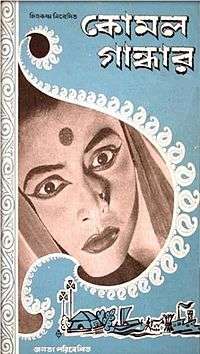Komal Gandhar
| Komal Gandhar (A Soft Note on a Sharp Scale) | |
|---|---|
|
A poster for Komal Gandhar. | |
| Directed by | Ritwik Ghatak |
| Produced by | Ritwik Ghatak |
| Screenplay by | Ritwik Ghatak |
| Music by |
Jyotirindra Moitra Lyrics: Rabindranath Tagore |
| Cinematography | Dilip Ranjan Mukhopadhyay |
| Edited by | Ramesh Joshi |
Release dates | 31 March 1961 |
| Country | India |
| Language | Bengali |
Komal Gandhar (Bengali: কোমল গান্ধার Kōmal Gāndhār),[1] also known as A Soft Note on a Sharp Scale, is a 1961 Bengali film[2] written and directed by noted film maker Ritwik Ghatak.[3][4][5] The title refers to the Hindustani equivalent of "E-flat". It was part of the trilogy, Meghe Dhaka Tara (1960), Komal Gandhar, and Subarnarekha (1962), all dealing with the aftermath of the Partition of India in 1947 and the refugees coping with it, though this was the most optimistic film of his oeuvre.[6] The film explores three themes juxtaposed in the narrative: the dilemma of Anusuya, the lead character, the divided leadership of IPTA, and the fallout from the partition of India.[7]
Overview
The title was taken from the line of a poem[lower-alpha 1] by Rabindranath Tagore that meant a sur or note, E-flat. As in other films by Ghatak, music plays a pivotal role in the movie.
Through the microcosmic perspectivising of a group of devoted and uncompromising IPTA workers, Ghatak with his signature style touches on varied issues of partition, idealism, corruption, the interdependence of art and life, the scope of art, and class-struggle. Unlike his other films, this one runs along an upbeat mood with the lead pair of lovers (Vrigu and Anusua) being reunited.
Cast
- Abanish Bannerjee as Bhrigu
- Bijon Bhattacharya as Gagan
- Satindra Bhattacharya as Shibnath
- Debabrata Biswas
- Chitra Sen as Jaya
- Anil Chatterjee as Rishi
- Satyabrata Chattopadhyay
- Supriya Devi as Anusuya
- Gita Dey as Shanta
Soundtrack
Music was by Jyotirindra Moitra, from IPTA, and a noted Rabindra Sangeet exponent who had previously given music in Ghatak's Meghe Dhaka Tara (1960), and had song by singers like, Bijon Bhattacharya, Debabrata Biswas, Hemanga Biswas. Bahadur Khan played sarod in the soundtrack. The film is noted for its wedding songs and also contrapuntal use of sound.[8]
See also
References
Citation
- ↑ Manju Jain (1 August 2009). Narratives Of Indian Cinema. Primus Books. pp. 81–. ISBN 978-81-908918-4-4. Retrieved 8 July 2012.
- ↑ Robert Burgoyne (1 August 2009). The Epic Film. Taylor & Francis. pp. 394–. ISBN 978-0-415-99017-2. Retrieved 8 July 2012.
- ↑ "E-Flat (1961)". New York Times. Retrieved 3 August 2012.
- ↑ "Jinxed legacy". Hinduonnet.com. Retrieved 2010-03-06.
- ↑ "Of Time And The River…". www.outlookindia.com. 2006-07-21. Retrieved 2010-03-06.
- ↑ Rosalind Galt; Karl Schoonover (2010). Global Art Cinema: New Theories and Histories. Oxford University Press. ISBN 0-19-538562-4.
- ↑ Haimanti Banerjee (1985). Ritwik Kumar Ghatak: a monograph. National Film Archive of India. pp. 62–3. ISBN 81-201-0001-8.
- ↑ Indian horizons, Volume 44. Indian Council for Cultural Relations., 1995. p. 127.
